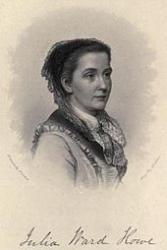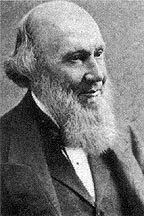Planning worship?
Check out our sister site, ZeteoSearch.org,
for 20+ additional resources related to your search.
- |
User Links
Search Results
Glory! glory! Hallelujah!
Author: Julia Ward Howe Meter: 15.15.15.6 with refrain Appears in 570 hymnals First Line: Mine eyes have seen the glory of the coming of the Lord Lyrics:
Mine eyes have seen the glory of the coming of the Lord;
He is trampling out the vintage where the grapes of wrath are stored;
He hath loosed the fateful lightning of his terrible swift sword;
His truth is marching on.
Glory! glory! Hallelujah! His truth is marching on.
I have seen him in the watch-fires of a hundred circling camps;
They have builded him an altar in the evening dews and damps;
I have read his righteous sentence by the dim and flaring lamps;
His day is marching on.
Glory! glory! Hallelujah! His day is marching on.
I have read a fiery gospel, writ in burnished rows of steel;
"As ye deal with my contemners, so with you my grace shall deal;"
Let the Hero, born of woman, crush the serpent with his heel,
Since God is marching on.
Glory! glory! Hallelujah! Since God is marching on.
He has sounded forth his trumpet that shall never call retreat;
He is sifting out the hearts of men before His judgment-seat;
O be swift, my soul, to answer him: be jubilant, my feet!
Our God is marching on.
Glory! glory! Hallelujah! Our God is marching on.
In the beauty of the lilies Christ was born, across the sea,
With a glory in his bosom that transfigures you and me;
As he died to make men holy, let us die to make men free!
While God is marching on.
Glory! glory! Hallelujah! While God is marching on.
Topics: National Days; Sunday Schools National Days Used With Tune: BATTLE HYMN
Glory! glory! Hallelujah!
BATTLE HYMN OF THE REPUBLIC
Meter: 15.15.15.6 with refrain Appears in 488 hymnals Tune Sources: USA campmeeting tune, 19th cent. Tune Key: B Flat Major Incipit: 55554 35123 33211 Used With Text: The Battle Hymn of the Republic
BATTLE HYMN OF THE REPUBLIC
Mine Eyes Have Seen the Glory
Author: Julia Ward Howe Hymnal: The Hymnal for Boys and Girls #81 (1936) Meter: 15.15.15.6 with refrain First Line: Mine eyes have seen the glory of the coming of the Lord Refrain First Line: Glory, glory, hallelujah Lyrics: 1 Mine eyes have seen the glory of the coming of the Lord;
He is trampling out the vintage where the grapes of wrath are stored;
He hath loosed the fateful lightning of his terrible swift sword;
His truth is marching on.
Refrain:
Glory! glory! Hallelujah!
Glory! glory! Hallelujah!
Glory! glory! Hallelujah!
His truth is marching on.
2 I have seen him in the watch-fires of a hundred circling camps;
They have builded him an altar in the evening dews and damps;
I have read his righteous sentence by the dim and flaring lamps;
His day is marching on.
Refrain:
Glory! glory! Hallelujah!
Glory! glory! Hallelujah!
Glory! glory! Hallelujah!
His day is marching on.
3 He has sounded forth his trumpet that shall never sound retreat;
He is sifting out the hearts of men before His judgment seat;
O be swift, my soul, to answer him: be jubilant, my feet!
Our God is marching on.
Refrain:
Glory! glory! Hallelujah!
Glory! glory! Hallelujah!
Glory! glory! Hallelujah!
Our God is marching on.
4 In the beauty of the lilies Christ was born across the sea,
With a glory in his bosom that transfigures you and me;
As he died to make men holy, let us die to make men free!
While God is marching on.
Refrain:
Glory! glory! Hallelujah!
Glory! glory! Hallelujah!
Glory! glory! Hallelujah!
While God is marching on.
Amen.
Topics: Our Country Tune Title: BATTLE HYMN OF THE REPUBLIC
Mine Eyes Have Seen the Glory
Mine Eyes Have Seen the Glory
Author: Julia Ward Howe Hymnal: Lutherförbundets Sångbok #E180 (1913) Meter: 15.15.15.6 with chorus First Line: Mine eyes have seen the glory of the coming of the Lord Refrain First Line: glory! glory, hallelujah! Lyrics: 1 Mine eyes have seen the glory of the coming of the Lord;
He is trampling out the vintage where the grapes of wrath are stored;
He hath loosed the fateful lightning of His terrible swift sword;
His truth is marching on.
Chorus:
Glory! glory, hallelujah!
Glory! glory, hallelujah!
Glory! glory, hallelujah!
His truth is marching on.
2 I have seen Him in the watch-fires of a hundred circling camps;
They have builded Him an altar in the evening dews and damps;
I can read His righteous sentence by the dim and glaring lamps;
His day is marching on. [Chorus]
3 He has sounded forth the trumpet that shall never call retreat;
He is sifting out the hearts of men before His judgment seat;
Oh, be swift, my soul, to answer Him! be jubilant, my feet;
Our God is marching on. [Chorus]
4 In the beauty of the lilies, Christ was born across the sea,
With a glory in His bosom that transfigures you and me;
As He died to make men holy, let us die to make men free;
While God is marching on. [Chorus] Topics: Patriotic Languages: English Tune Title: BATTLE HYMN OF THE REPUBLIC
Mine Eyes Have Seen the Glory
Mine Eyes Have Seen the Glory
Author: Mrs. Julia Ward Howe Hymnal: Epworth Praises #178 (1909) First Line: Mine eyes have seen the glory of the coming of the Lord Refrain First Line: Glory! Glory! Hallelujah Languages: English Tune Title: [Mine eyes have seen the glory of the coming of the Lord]
Mine Eyes Have Seen the Glory
Julia Ward Howe

1819 - 1910 Author of "Glory! glory! Hallelujah!" in The Hymnal Born: May 27, 1819, New York City.
Died: October 17, 1910, Middletown, Rhode Island.
Buried: Mount Auburn Cemetery, Cambridge, Massachusetts.
Howe, Julia, née Ward, born in New York City in 1819, and married in 1843 the American philanthropist S. G. Howe. She has taken great interest in political matters, and is well known through her prose and poetical works. Of the latter there are Passion Flower, 1854; Words of the Hour, 1856; Later Lyrics, 1866; and From Sunset Ridge, 1896. Her Battle Hymn of the Republic, "eyes have seen the glory of the coming of the Lord," was written in 1861 at the outbreak of the Civil War, and was called forth by the sight of troops for the seat of war, and published in her Later Lyrics, 1806, p. 41. It is found in several American collections, including The Pilgrim Hymnal, 1904, and others. [M. C. Hazard, Ph.D.]
--John Julian, Dictionary of Hymnology, New Supplement (1907)
============================
Howe, Julia Ward. (New York, New York, May 27, 1819--October 17, 1910). Married Samuel Gridley Howe on April 26, 1843. She was a woman with a distinguished personality and intellect; an abolitionist and active in social reforms; author of several book in prose and verse. The latter include Passion Flower, 1854; Words of the Hours, 1856; Later Lyrics, 1866; and From a Sunset Ridge, 1896.
She became famous as the author of the poem entitled "Battle Hymn of the Republic," which, in spite of its title, was written as a patriotic song and not as a hymn for use in public worship, but which has been included in many American hymn books. It was written on November 19, 1861, while she and her husband, accompanied by their pastor, Rev. James Freeman Clarke, minister of the (Unitarian) Church of the Disciples, Boston, were visiting Washington soon after the outbreak of the Civil War. She had seen the troops gathered there and had heard them singing "John Brown's body lies a-mouldering in the grave" to a popular tune called "Glory, Hallelujah" composed a few years earlier by William Steffe of Charleston, South Carolina, for Sunday School use. Dr. Clarke asked Julie Howe if she could not write more uplifting words for the tune and as she woke early the next morning she found the verses forming in her mind as fast as she could write them down, so completely that later she re-wrote only a line or two in the last stanza and changed only four words in other stanzas. She sent the poem to The Atlantic Monthly, which paid her $4 and published it in its issue for February, 1862. It attracted little attention until it caught the eye of Chaplain C. C. McCable (later a Methodist bishop) who had a fine singing voice and who taught it first to the 122nd Ohio Volunteer Infantry regiment to which he was attached, then to other troops, and to prisoners in Libby Prison after he was made a prisoner of war. Thereafter it quickly came into use throughout the North as an expression of the patriotic emotion of the period.
--Henry Wilder Foote, DNAH Archives
Julia Ward Howe
E. J. Hopkins

1818 - 1901 Person Name: E. Hopkins Arranger of "JOHN BROWN" in The New Canadian Hymnal Dr Edward John Hopkins MusDoc United Kingdom 1818-1901. Born at Westminster, England, the son of a clarinetist with the Royal Opera House orchestra, he became an organist (as did two of his brothers) and a composer. In 1826 he became a chorister of the Chapel Royal and sang at the coronation of King William IV in Westminster Abbey. He also sang in the choir of St. Paul’s Cathedral, a double schedule requiring skill and dexterity. On Sunday evenings he would play the outgoing voluntary at St. Martin’s in-the-field. He left Chapel Royal in 1834 and started studying organ construction at two organ factories. He took an appointment at Mitcham Church as organist at age 16, winning an audition against other organists. Four years later he became organist at the Church of St. Peter, Islington. In 1841 he became organist at St. Luke’s, Berwick St., Soho. Two Years later he was organist at Temple Church, which had a historic organ (built in 1683). He held this position for 55 years. In 1845 he married Sarah Lovett, and they had four sons and five daughters. He was closely associated with the Bach Society and was organist for the first English performances of Bach’s St. Matthew Passion. In 1855 he collaborated with Edward Rimbault publishing “The organ, its history and construction” (3 editions 1855-70-77). In 1864 he was one of the founders of the “College of organists”. In 1882 he received an honorary Doctorate of Music from the Archbishop of Canterbury. He composed 30+ hymn tunes and some psalm chants, used by the Church of England. He died in London, England.
John Perry
E. J. Hopkins
Anonymous
Person Name: Anon. Composer of "BATTLE HYMN OF THE REPUBLIC" in Cân a Mawl In some hymnals, the editors noted that a hymn's author is unknown to them, and so this artificial "person" entry is used to reflect that fact. Obviously, the hymns attributed to "Author Unknown" "Unknown" or "Anonymous" could have been written by many people over a span of many centuries.
Anonymous


 My Starred Hymns
My Starred Hymns

